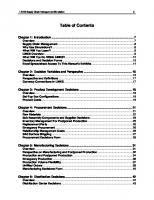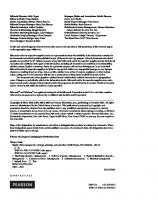Essentials of Supply Chain Management - Fifth Edition [5 ed.] 9781394217328, 9781394217311, 9781394217335
In the newly updated fifth edition of Essentials of Supply Chain Management, supply chain veteran Michael Hugos delivers
125 11 44MB
English Pages 416 Year 2024
Table of contents :
Cover
Table of Contents
Title Page
Copyright
Dedication
Preface
CHAPTER 1: Key Concepts of Supply Chain Management
Nothing Entirely New—Just a Significant Evolution
How the Supply Chain Works
The Evolving Structure of Supply Chains
Participants in the Supply Chain
Aligning the Supply Chain with Business Strategy
Chapter Summary
CHAPTER 2: Supply Chain Operations
A Model of Supply Chain Operations
Demand Forecasting and Planning (Plan)
Product Pricing (Plan)
Inventory Management (Plan)
Credit and Collections (Source)
Chapter Summary
CHAPTER 3: Supply Chain Operations
Product Design (Make)
Production Scheduling (Make)
Facility Management (Make)
Order Management (Deliver)
Delivery Scheduling (Deliver)
Return Processing (Deliver)
Supply Chain Operations Can Be Outsourced
Chapter Summary
CHAPTER 4: New Technology Changes How Work Is Done
New Technology Is Changing Supply Chain Operations
Key Components of Information Technology
New Supply Chain Technology
Impact on Supply Chain Operations
Combining New Technologies for Agile Supply Chains
Chapter Summary
CHAPTER 5: Metrics for Measuring Supply Chain Performance
Useful Model of Markets and Their Supply Chains
Market Performance Categories
A Framework for Performance Measurement
Customer Service Metrics
Internal Efficiency Metrics
Demand Flexibility Metrics
Product Development Metrics
Operations that Enable Supply Chain Performance
Collecting and Displaying Performance Data
Three Levels of Detail
Spotlighting Problems and Finding Opportunities
Markets Migrate from One Quadrant to Another
Sharing Data across the Supply Chain
Chapter Summary
CHAPTER 6: Supply Chain Coordination and Risk Management
The Bullwhip Effect
Coordination in the Supply Chain
Supply Chain Product Data Standards
Sales and Operations Planning
How to Start Supply Chain Collaboration
Supply Chain Risk Management
Chapter Summary
CHAPTER 7: Supply Chain Innovation for the Real-Time Economy
Supply Chain Performance Depends on Timely Data
Coordination and Collaboration in Supply Chains
Use Collaboration to Reinvent Supply Chain Operations
Process for Collaborative Supply Chain Operations
Chapter Summary
CHAPTER 8: Defining Supply Chain Opportunities
The Supply Chain as a Competitive Advantage
Identify the Business Opportunity and Define the Goal
Create the Strategy
Create a Conceptual System Design
Strategic Guidelines for Designing Systems
Define Project Objectives
Create an Initial Project Plan and Budget
Estimate the Project Budget and ROI
Define the Specific Costs and Benefits
Chapter Summary
CHAPTER 9: Creating Supply Chains for CompetitiveAdvantage
Assessing Technology Needs
Charlie Supply, Inc.—Initial Business Situation
New Opportunities Emerge—Follow-on Situation
Strategic Alliances for Competitive Advantage
Chapter Summary
CHAPTER 10: The Promise of Resilient and Sustainable Supply Chains
The Start of Something Big
Winning at the Game of Real-Time Supply Chains
Chapter Summary
About the Author
Index
End User License Agreement
Cover
Table of Contents
Title Page
Copyright
Dedication
Preface
CHAPTER 1: Key Concepts of Supply Chain Management
Nothing Entirely New—Just a Significant Evolution
How the Supply Chain Works
The Evolving Structure of Supply Chains
Participants in the Supply Chain
Aligning the Supply Chain with Business Strategy
Chapter Summary
CHAPTER 2: Supply Chain Operations
A Model of Supply Chain Operations
Demand Forecasting and Planning (Plan)
Product Pricing (Plan)
Inventory Management (Plan)
Credit and Collections (Source)
Chapter Summary
CHAPTER 3: Supply Chain Operations
Product Design (Make)
Production Scheduling (Make)
Facility Management (Make)
Order Management (Deliver)
Delivery Scheduling (Deliver)
Return Processing (Deliver)
Supply Chain Operations Can Be Outsourced
Chapter Summary
CHAPTER 4: New Technology Changes How Work Is Done
New Technology Is Changing Supply Chain Operations
Key Components of Information Technology
New Supply Chain Technology
Impact on Supply Chain Operations
Combining New Technologies for Agile Supply Chains
Chapter Summary
CHAPTER 5: Metrics for Measuring Supply Chain Performance
Useful Model of Markets and Their Supply Chains
Market Performance Categories
A Framework for Performance Measurement
Customer Service Metrics
Internal Efficiency Metrics
Demand Flexibility Metrics
Product Development Metrics
Operations that Enable Supply Chain Performance
Collecting and Displaying Performance Data
Three Levels of Detail
Spotlighting Problems and Finding Opportunities
Markets Migrate from One Quadrant to Another
Sharing Data across the Supply Chain
Chapter Summary
CHAPTER 6: Supply Chain Coordination and Risk Management
The Bullwhip Effect
Coordination in the Supply Chain
Supply Chain Product Data Standards
Sales and Operations Planning
How to Start Supply Chain Collaboration
Supply Chain Risk Management
Chapter Summary
CHAPTER 7: Supply Chain Innovation for the Real-Time Economy
Supply Chain Performance Depends on Timely Data
Coordination and Collaboration in Supply Chains
Use Collaboration to Reinvent Supply Chain Operations
Process for Collaborative Supply Chain Operations
Chapter Summary
CHAPTER 8: Defining Supply Chain Opportunities
The Supply Chain as a Competitive Advantage
Identify the Business Opportunity and Define the Goal
Create the Strategy
Create a Conceptual System Design
Strategic Guidelines for Designing Systems
Define Project Objectives
Create an Initial Project Plan and Budget
Estimate the Project Budget and ROI
Define the Specific Costs and Benefits
Chapter Summary
CHAPTER 9: Creating Supply Chains for CompetitiveAdvantage
Assessing Technology Needs
Charlie Supply, Inc.—Initial Business Situation
New Opportunities Emerge—Follow-on Situation
Strategic Alliances for Competitive Advantage
Chapter Summary
CHAPTER 10: The Promise of Resilient and Sustainable Supply Chains
The Start of Something Big
Winning at the Game of Real-Time Supply Chains
Chapter Summary
About the Author
Index
End User License Agreement
![Essentials of Supply Chain Management - Fifth Edition [5 ed.]
9781394217328, 9781394217311, 9781394217335](https://ebin.pub/img/200x200/essentials-of-supply-chain-management-fifth-edition-5nbsped-9781394217328-9781394217311-9781394217335.jpg)
![Essentials of Supply Chain Management [1 ed.]
9780471235170, 0471235172](https://ebin.pub/img/200x200/essentials-of-supply-chain-management-1nbsped-9780471235170-0471235172.jpg)





![Supply Chain Strategy: The Logistics of Supply Chain Management [1 ed.]
9780071375993, 9780071418171, 0071375996](https://ebin.pub/img/200x200/supply-chain-strategy-the-logistics-of-supply-chain-management-1nbsped-9780071375993-9780071418171-0071375996.jpg)
![Essentials of Supply Chain Management [1 ed.]
0471235172, 9780471235170, 9780471434290](https://ebin.pub/img/200x200/essentials-of-supply-chain-management-1nbsped-0471235172-9780471235170-9780471434290.jpg)

